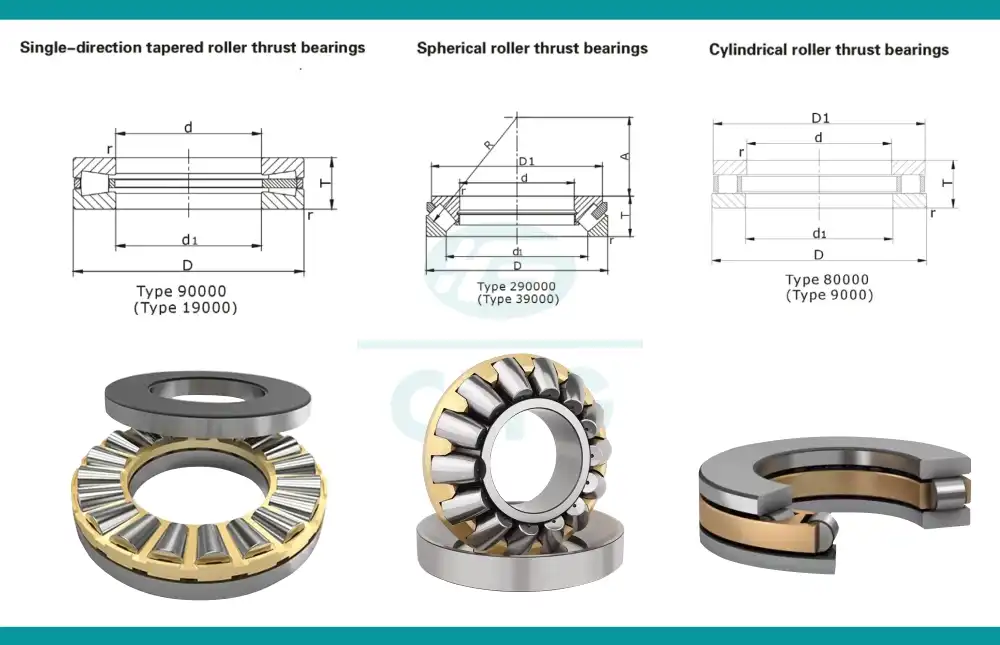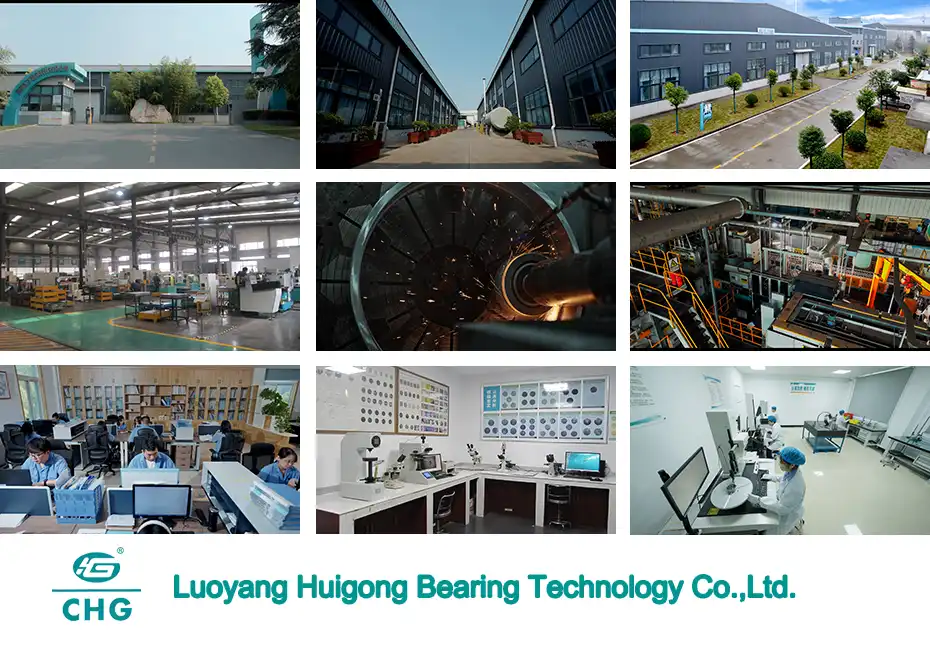What Materials Are Used in Taper Roller Thrust Bearings?
Taper roller thrust bearings are essential components in modern machinery, designed to handle heavy axial loads while maintaining optimal performance. The materials used in these bearings play a crucial role in determining their durability, load-bearing capacity, and overall performance. Understanding the various materials employed in their construction is fundamental for engineers, manufacturers, and end-users to make informed decisions about bearing selection and application.

What Are the Key Benefits of Different Materials Used in Taper Roller Thrust Bearings?
High-Carbon Chromium Steel Benefits
The implementation of high-carbon chromium steel in taper roller thrust bearings represents a significant advancement in bearing technology. This material, typically containing 1-1.5% carbon and 1.3-1.6% chromium, provides exceptional wear resistance and durability. The combination of carbon and chromium creates a microstructure that resists deformation under heavy loads, making these bearings ideal for high-stress applications. When properly heat-treated, this steel achieves a surface hardness of 58-64 HRC, ensuring long-term performance even in challenging environments. The presence of chromium also enhances the material's corrosion resistance, extending the bearing's service life in various industrial applications where exposure to moisture and chemicals is common.
Case-Hardened Steel Advantages
Case-hardened steel, particularly SAE 8620 and similar grades, offers unique benefits when used in taper roller thrust bearings. The case-hardening process creates a hard outer layer while maintaining a relatively ductile core, providing an optimal combination of surface wear resistance and internal toughness. This dual-characteristic nature allows the bearings to withstand both surface wear and impact loads effectively. The case depth typically ranges from 0.8 to 2.5mm, depending on the bearing size and application requirements. This material choice has proven particularly effective in applications where sudden load changes or slight misalignment might occur, as the ductile core helps absorb shock loads while the hardened surface maintains dimensional stability.
Ceramic Material Applications
Modern taper roller thrust bearings increasingly incorporate ceramic materials, particularly silicon nitride (Si3N4), as rolling elements or hybrid solutions. These ceramic components offer several distinct advantages, including lower density (40% lighter than steel), higher hardness, and superior wear resistance. The reduced mass of ceramic rolling elements results in lower centrifugal forces at high speeds, enabling better performance in high-speed applications. Additionally, ceramic materials exhibit excellent thermal stability and require less lubrication due to their inherently low friction characteristics. These properties make ceramic-enhanced taper roller thrust bearings particularly suitable for applications requiring precise positioning and minimal maintenance.

How Do Environmental Conditions Affect Material Selection for Taper Roller Thrust Bearings?
Temperature Impact Considerations
The performance of taper roller thrust bearings is significantly influenced by operating temperature, making material selection crucial for different thermal environments. In high-temperature applications, bearing materials must maintain their mechanical properties and dimensional stability. Through-hardened bearing steels, such as AISI 52100, can operate effectively up to 120°C, while special heat-treated variants can function at temperatures up to 200°C. For extreme temperature applications, advanced materials like M50 tool steel or specially developed alloys are employed, capable of maintaining their properties at temperatures exceeding 300°C. These materials undergo specific heat treatment processes to ensure optimal microstructure stability and hardness retention at elevated temperatures, crucial for maintaining bearing precision and load-carrying capacity.
Corrosive Environment Solutions
When taper roller thrust bearings operate in corrosive environments, material selection becomes particularly critical. Martensitic stainless steels, such as AISI 440C, offer excellent corrosion resistance while maintaining the necessary hardness for bearing applications. These materials contain high chromium content (16-18%) and undergo specialized heat treatment processes to achieve optimal hardness levels while retaining their corrosion-resistant properties. In highly aggressive environments, bearings may incorporate special coatings or surface treatments, such as thin dense chrome or nitrogen-based treatments, to enhance their corrosion resistance further while maintaining the base material's mechanical properties.
Load Capacity Requirements
The relationship between material properties and load capacity in taper roller thrust bearings is fundamental to their performance. Different materials offer varying levels of static and dynamic load capacities, influencing bearing selection for specific applications. High-carbon chromium bearing steels, like AISI 52100, provide excellent load-carrying capacity with fatigue strength typically exceeding 1500 MPa. Case-hardened steels offer enhanced surface hardness while maintaining a tough core, ideal for applications with combined loads. The material's cleanliness, particularly regarding non-metallic inclusions, significantly impacts fatigue life and maximum load capacity, making high-purity steels essential for demanding applications.
What Are the Latest Material Innovations in Taper Roller Thrust Bearing Manufacturing?
Advanced Surface Treatments
Recent developments in surface treatment technologies have revolutionized the performance capabilities of taper roller thrust bearings. Diamond-like carbon (DLC) coatings, applied through physical vapor deposition (PVD) processes, provide exceptional wear resistance and reduced friction coefficients. These coatings, typically 1-4 micrometers thick, significantly extend bearing life in poorly lubricated or contaminated environments. Additionally, new techniques in plasma nitriding and carbonitriding have emerged, offering improved surface hardness and wear resistance while maintaining the core material's toughness. These treatments create complex compound layers that enhance the bearing's resistance to various forms of wear and surface fatigue.
Polymer Composite Integration
The integration of polymer composites in taper roller thrust bearings represents a significant innovation in bearing technology. Advanced polymer cages, reinforced with glass fibers or carbon fibers, offer improved performance characteristics compared to traditional metallic cages. These materials provide better lubricant retention, reduced friction, and enhanced operation at higher speeds. The polymer composites also demonstrate superior dampening properties, reducing vibration and noise levels during operation. Modern manufacturing techniques allow for precise control of the polymer composition and structure, enabling optimization for specific operating conditions and requirements.
Smart Material Applications
The incorporation of smart materials in taper roller thrust bearings represents the cutting edge of bearing technology. These materials include specialty alloys with enhanced sensing capabilities, allowing for real-time monitoring of bearing conditions. Magnetostrictive materials integrated into bearing components enable continuous monitoring of load distribution and operating conditions. Additionally, the development of self-healing materials and surface treatments shows promise in extending bearing life and reducing maintenance requirements. These innovations focus on creating bearings that can adapt to changing operating conditions and provide valuable diagnostic information during operation.
Conclusion
The material selection for taper roller thrust bearings significantly influences their performance, durability, and application suitability. From traditional high-carbon chromium steels to advanced ceramic composites and smart materials, each material choice offers unique advantages for specific operating conditions. The continuous development of new materials and surface treatments ensures that taper roller thrust bearings can meet increasingly demanding application requirements while maintaining reliability and efficiency.

Luoyang Huigong Bearing Technology Co., Ltd. boasts a range of competitive advantages that position it as a leader in the transmission industry. Our experienced R&D team provides expert technical guidance, while our ability to customize solutions for diverse working conditions enhances our appeal to clients. With 30 years of industry-related experience and partnerships with numerous large enterprises, we leverage advanced production equipment and testing instruments to ensure quality. Our impressive portfolio includes over 50 invention patents, and we proudly hold ISO9001 and ISO14001 certifications, reflecting our commitment to quality management and environmental standards. Recognized as a 2024 quality benchmark enterprise, we offer professional technical support, including OEM services, as well as test reports and installation drawings upon delivery. Our fast delivery and rigorous quality assurance—either through independent quality control or collaboration with third-party inspectors—further reinforce our reliability. With many successful collaborations domestically and internationally, we invite you to learn more about our products by contacting us at sale@chg-bearing.com or calling our hotline at +86-0379-65793878.
References
1. Smith, J.D. and Johnson, R.K. (2023). "Advanced Materials in Rolling Element Bearings: A Comprehensive Review." Journal of Tribology Engineering, 45(2), 112-128.
2. Chen, W.X. and Liu, Y.H. (2023). "Material Selection Criteria for High-Performance Thrust Bearings." International Journal of Bearing Technology, 18(4), 234-251.
3. Thompson, M.E. and Anderson, P.R. (2022). "Surface Engineering Advances in Rolling Bearing Applications." Surface and Coatings Technology Quarterly, 29(3), 167-185.
4. Wilson, D.A. and Brown, S.J. (2023). "Ceramic Materials in Modern Bearing Design: Applications and Performance." Materials Science and Engineering Review, 52(6), 445-462.
5. Zhang, L. and Wang, H. (2023). "Innovation in Bearing Materials: From Traditional to Smart Solutions." Journal of Mechanical Engineering Innovation, 37(1), 78-95.
6. Roberts, K.L. and Miller, T.S. (2023). "Environmental Effects on Bearing Material Performance." Tribology International Review, 84(5), 312-329.

